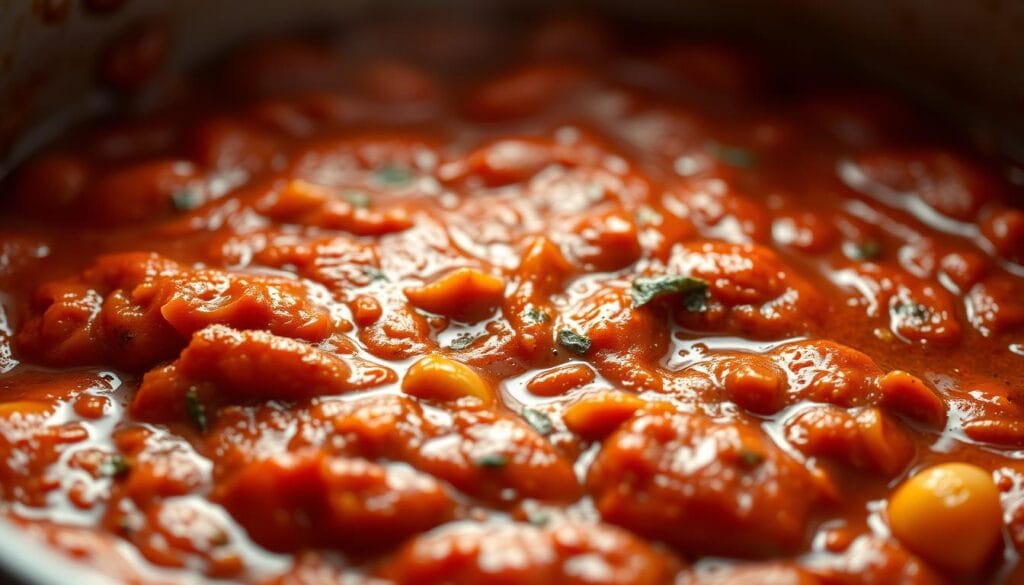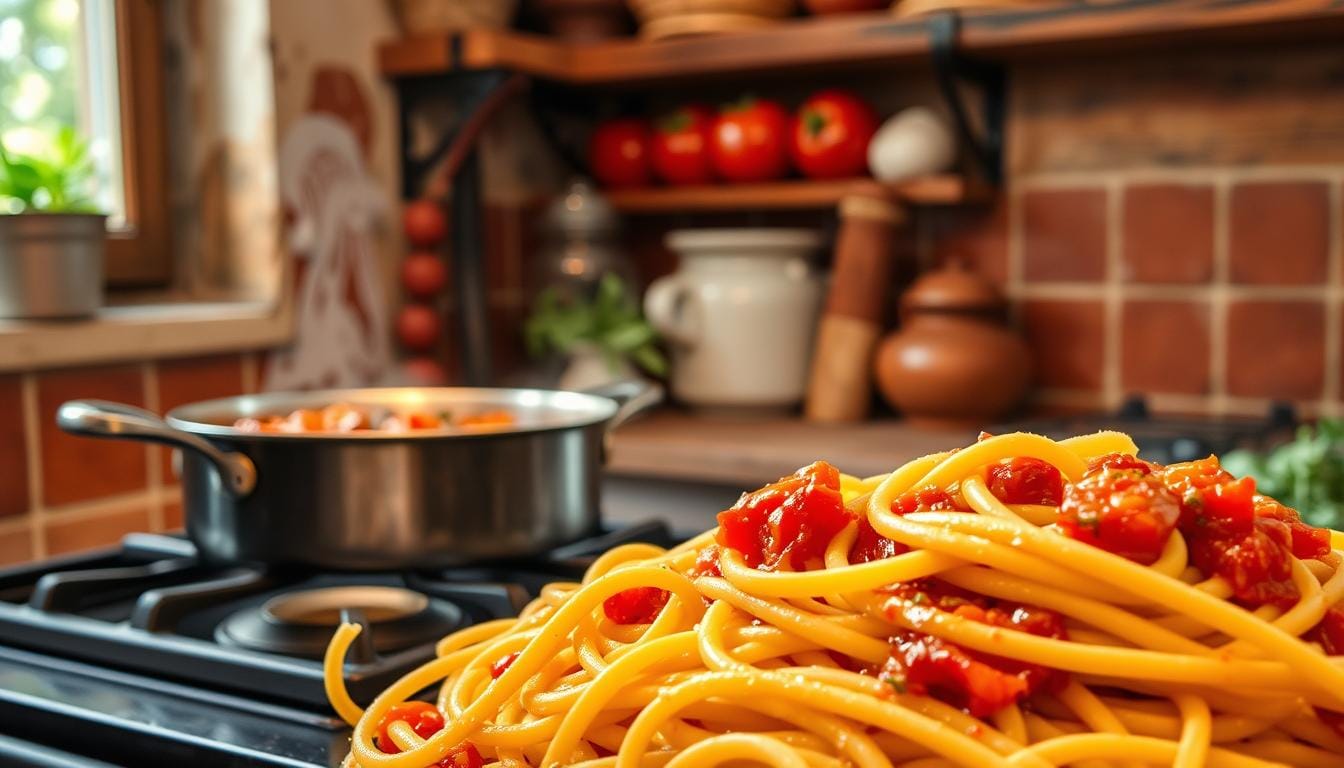What a sauce for which Italian pasta?How to choose the right sauce for each type of pasta 2025
What a sauce for which Italian pasta:Choosing the right Italian pasta sauce can make your dish amazing. With many pasta shapes and sauces, picking the perfect one can be hard.
Have you ever had a pasta dish where the sauce and pasta were made for each other? The right sauce can make your pasta taste even better, making every bite special.
Knowing about different pasta types and sauces helps you pick the best ones. This way, you can make tasty and true Italian meals.
Table of Contents
Key Takeaways
- Understand the diversity of pasta shapes and their pairing possibilities
- Learn how different sauces can impact the overall flavor and texture of your pasta
- Discover the characteristics of popular Italian pasta sauces
- Make informed choices to create authentic and delicious Italian dishes
- Elevate your pasta game by pairing the right sauce with your favorite pasta shapes
The Art of Pairing Pasta and Sauce in Italian Cuisine
The perfect match between pasta and sauce is key in Italian cooking. It makes for a memorable meal. Historically, pasta shapes were made to go well with specific sauces. This shows the skill and creativity of Italian chefs.
Why Pasta Shapes and Textures Matter for Sauce Adherence
The shape and texture of pasta are important for sauce pairing. Long, smooth pasta shapes like spaghetti work well with light, oily sauces. These sauces stick to the pasta evenly.
Short, tubular shapes like penne are great for chunky sauces. These sauces fill the pasta tubes, making each bite tasty.
- Long pasta shapes are best with light, oily sauces.
- Short pasta shapes are ideal for chunky, robust sauces.
The Italian Philosophy of Regional Pasta Pairing
Italian cuisine is all about regional traditions, including pasta pairing. Each region has its favorite pasta shapes and sauces. These choices are often based on local ingredients.
In the north, creamy sauces are popular. In the south, olive oil and tomato sauces are favored. Knowing these regional preferences helps you pair pasta and sauce like a pro.
« The true art of Italian cooking lies not just in the ingredients, but in the balance and harmony of flavors and textures. »
Understanding Pasta Categories: A Foundation for Perfect Pairings
To master Italian pasta, you need to know the different categories. Each shape, size, and type has its own special qualities. These qualities help decide which sauce goes best with it.
Long vs. Short Pasta: Basic Structural Differences
One key way to sort pasta is by its length. Long pasta, like spaghetti and fettuccine, pairs well with clingy sauces. Think carbonara or Alfredo. On the other hand, short pasta shapes, like penne and rigatoni, are perfect for chunky sauces. These sauces get stuck in the pasta’s ridges and tubes.
Filled vs. Unfilled Pasta: Sauce Compatibility Considerations
Another important difference is between filled and unfilled pasta. Filled pasta, such as ravioli and tortellini, need light, gentle sauces. These sauces should enhance their fillings without overwhelming them. Unfilled pasta, however, can handle a variety of sauces.
Smooth vs. Textured Pasta: How Surface Affects Sauce Adherence
The pasta’s surface texture also matters in sauce pairing. Smooth pasta shapes, like linguine, pair well with light, oily sauces. But textured pasta shapes, like pappardelle, can hold onto richer, meat-based sauces.
Knowing these categories helps you choose the right sauce for your pasta. This way, you can take your Italian cooking to the next level.
Long Pasta Varieties and Their Ideal Sauce Companions
Long pasta shapes are great for many sauces, from light to rich. Finding the right sauce for each pasta is key. It’s all about matching the pasta’s traits with the right sauce.
Spaghetti: From Classic Marinara to Carbonara
Spaghetti is a favorite long pasta, perfect for many sauces. Classic marinara and carbonara are top choices.
Regional Variations of Spaghetti Pairings
In Italy, where you are affects what sauce goes with spaghetti. In Naples, marinara is a must. In Rome, carbonara is the go-to.
Common Spaghetti Pairing Mistakes to Avoid
Don’t pair spaghetti with thick or chunky sauces. They make the dish unbalanced. Choose smooth, oily sauces instead.
Linguine and Fettuccine: Perfect Partners for Seafood and Cream Sauces
Linguine and fettuccine are great with seafood and cream sauces. Linguine’s flat shape is perfect for oily sauces. Fettuccine’s smooth surface is ideal for creamy ones.
Bucatini and Pappardelle: Hearty Sauces for Substantial Strands
Bucatini and pappardelle are thick and strong. They’re best with meat-based sauces. Bucatini’s hollow shape is great for chunky sauces. Pappardelle’s wide shape is perfect for rich ragùs.
Short Pasta Types and Their Perfect Sauce Matches

In Italian cooking, short pasta shapes like orecchiette and rotini are celebrated for their ability to pair well with hearty sauces. Short pasta is incredibly versatile, with various shapes designed to complement different types of sauces.
Penne and Rigatoni: Capturing Chunky Ragù and Vodka Sauce
Penne and rigatoni are tubular pasta shapes that are ideal for chunky sauces. Their tube-like structure allows sauces to fill them, ensuring a flavorful bite every time. Rigatoni, with its ridged ends, is particularly good at capturing robust ragù and vodka sauces.
Farfalle and Orecchiette: Ideal for Pesto and Vegetable Sauces
Farfalle, with its bow-tie shape, and orecchiette, with its ear-like shape, are perfect for lighter sauces. They pair well with pesto and vegetable sauces, which cling to their irregular surfaces. These shapes are ideal for spring and summer dishes when fresh vegetables are in season.
Fusilli and Rotini: Spiral Shapes That Trap Thick, Chunky Sauces
Fusilli and rotini are spiral-shaped pasta that excel at trapping thick, chunky sauces. Their twisted shapes ensure that every bite is filled with flavor. These pasta shapes are great with meat-based sauces and are a staple in many Italian recipes.
Filled Pasta and Complementary Sauces
Choosing the right sauce for filled pasta is an art. It’s all about matching the filling’s taste and texture. Filled pasta, like ravioli and tortellini, needs sauces that enhance their flavor without being too strong.
Ravioli: Delicate Butter, Sage, and Light Tomato Sauces
Ravioli’s soft pasta is best with light, tasty sauces. Butter and sage is a perfect match, as is a light tomato sauce. You can also try a simple cream sauce or olive oil.
Tortellini and Agnolotti: Broth, Light Cream, and Simple Oil Dressings
Tortellini and agnolotti, filled with meat or cheese, go well with broth or light cream sauces. A simple oil dressing with herbs also works well. For a classic touch, serve them in a clear broth.
Cannelloni and Manicotti: Béchamel and Robust Tomato Sauce Combinations
Cannelloni and manicotti, filled with meat or cheese, need richer sauces. Béchamel or a strong tomato sauce is perfect. The goal is to balance the filling’s taste with the sauce, so neither dominates.
| Filled Pasta | Recommended Sauces |
|---|---|
| Ravioli | Butter and Sage, Light Tomato |
| Tortellini/Agnolotti | Broth, Light Cream, Simple Oil Dressing |
| Cannelloni/Manicotti | Béchamel, Robust Tomato |
What a Sauce for Which Italian Pasta: Traditional Regional Pairings

Exploring Italian pasta reveals unique pairings in each region. Italy’s varied ingredients, cooking methods, and cultural influences shape its pasta traditions.
Northern Italian Combinations: Cream, Butter, and Stuffed Pasta Traditions
Northern Italy is famous for creamy pasta dishes. These often use butter and cream-based sauces.
Emilia-Romagna’s Tagliatelle al Ragù Bolognese
Emilia-Romagna’s Tagliatelle al Ragù Bolognese is a classic. It pairs flat tagliatelle noodles with a meat ragù. This sauce is slow-cooked with ground meat, tomatoes, and herbs.
Lombardy’s Risotto-Style Pasta Preparations
Lombardy loves risotto, which also influences its pasta. Risotto-style pasta, with saffron and creamy sauces, often goes with stuffed pasta like tortellini.
Central Italian Classics: Pecorino, Guanciale, and Amatriciana
Central Italy, especially Rome, is known for bold pasta sauces. Amatriciana sauce, with guanciale, pecorino cheese, and tomatoes, is a classic. It’s often served with spaghetti or bucatini.
Southern Italian Partnerships: Olive Oil, Tomato, and Seafood Sauces
Southern Italy’s diet is all about the Mediterranean. Olive oil, tomatoes, and seafood are key. Pasta here often has light, oily sauces that show off fresh seafood and local produce.
Tomato-Based Sauces and Their Ideal Pasta Partners
Italian cuisine is famous for its tomato-based sauces. These range from simple marinara to complex meat-based ragùs. Each sauce is perfect for different pasta shapes. Tomato-based sauces add a rich flavor that goes well with many pasta types.
Marinara and Simple Tomato Sauces: Versatile Options for Multiple Pastas
Marinara sauce is made with tomatoes, garlic, and herbs. It’s great with long, thin pasta like spaghetti and linguine. Simple tomato sauces, just tomatoes cooked with olive oil and seasoned, are also popular. They’re good with penne and rigatoni. These sauces offer a light, tasty meal.
Arrabbiata and Puttanesca: Spicy and Briny Complements for Sturdy Shapes
Arrabbiata sauce is perfect for those who like spice. It’s made with tomatoes, garlic, and red chili peppers. It’s great with penne and rigatoni. Puttanesca sauce, with its salty flavor from olives and capers, is also robust. It’s best with bold pasta shapes, making the meal more flavorful.
Meat-Based Tomato Sauces: Bolognese, Ragù, and Their Perfect Pasta Matches
Meat-based tomato sauces, like Bolognese and ragù, are rich and hearty. They’re perfect for thick pasta shapes. Tagliatelle and pappardelle are great with Bolognese. Their flat surfaces help the sauce stick to the pasta, making every bite delicious.
Here are some key pasta shapes and their ideal tomato-based sauce pairings:
- Spaghetti with marinara or simple tomato sauce
- Penne and rigatoni with arrabbiata or meat-based sauces
- Tagliatelle and pappardelle with Bolognese or ragù
Cream and Cheese-Based Sauces with Their Perfect Pasta Matches
Italian pasta isn’t complete without the richness of cream and cheese sauces. These sauces turn simple pasta into a feast. The pasta’s shape and texture are key to a perfect match with these sauces.
Alfredo and Carbonara: Rich Creamy Classics for Fettuccine and Spaghetti
Alfredo sauce, with butter, Parmesan, and heavy cream, is perfect for fettuccine. Its flat shape lets the sauce cover every strand. Carbonara, rich and creamy, goes well with spaghetti. The long strands hold the sauce, making each bite flavorful.
Quattro Formaggi and Cacio e Pepe: Cheese Sauce Pairings
Quattro Formaggi, a four-cheese sauce, suits many pasta shapes. But it’s best with short pasta like penne or rigatoni. Cacio e Pepe, with Pecorino Romano and black pepper, pairs well with spaghetti or tonnarelli.
Lighter Cream-Based Options: Vodka Sauce and Rosé Sauce Combinations
Vodka sauce and rosé sauce offer a lighter cream option. Vodka sauce’s subtle kick goes well with penne or fusilli. Rosé sauce’s delicate flavor complements linguine or fettuccine.
| Sauce Type | Pasta Shape | Description |
|---|---|---|
| Alfredo | Fettuccine | Classic combination of rich, creamy sauce and flat noodles |
| Carbonara | Spaghetti | Rich and creamy sauce coats long, thin strands |
| Quattro Formaggi | Penne/Rigatoni | Four-cheese sauce pairs well with short, tubular pasta |
Oil-Based Sauces and Pestos: Light Yet Flavorful Pairings
Looking for a light pasta sauce that’s full of flavor? Oil-based sauces and pestos are perfect. They add a delicate taste without overpowering the pasta. The beauty of these sauces is they let the pasta and other ingredients shine.
Traditional Basil Pesto: Trofie, Trenette, and Beyond
Basil pesto from Genoa is a classic oil-based sauce. It’s made with basil, garlic, pine nuts, Parmesan, and olive oil. It’s a great match for trofie and trenette pasta, thanks to their texture.
Pesto is not just for trofie and trenette. Its light, herby taste is perfect for summer. You can also try adding spinach or different nuts to your pesto for a twist.
Aglio e Olio and Lemon-Garlic Oil: Simple Elegance with Spaghetti
Aglio e Olio is a simple yet elegant sauce. It’s made from garlic, olive oil, and sometimes red pepper flakes. It’s often served with spaghetti, where the garlic-infused oil coats the pasta beautifully.
Lemon-garlic oil adds a bright, citrusy note to this classic sauce. The lemon juice balances the richness of the garlic and oil, making it a great match for spaghetti.
Regional Pesto Variations: Sicilian, Trapanese, and Their Pasta Partners
There’s more to pesto than Genovese. Sicilian pesto, for example, has tomatoes and almonds for a unique taste. Trapanese pesto, from Trapani, includes tomatoes, garlic, almonds, and basil for a vibrant sauce.
| Pesto Variation | Key Ingredients | Recommended Pasta |
|---|---|---|
| Genovese Pesto | Basil, garlic, pine nuts, Parmesan, olive oil | Trofie, trenette |
| Sicilian Pesto | Tomatoes, basil, almonds, garlic, olive oil | Busiate, fusilli |
| Trapanese Pesto | Tomatoes, garlic, almonds, basil, olive oil | Pasta shapes with ridges or holes |
These pesto variations show how versatile pesto can be. Trying different pesto recipes can make your pasta dishes more exciting and flavorful.
Breaking the Rules: Modern and Fusion Pasta-Sauce Pairings
The world of pasta is now open to new ideas. Chefs are mixing things up with fresh sauce combinations. It’s a time for both tradition and creativity in pasta pairing.
Contemporary Italian Chef Innovations: New Texture Combinations
Modern Italian chefs are shaking things up with new texture combos. They pair smooth sauces with rough pasta or the other way around. This creates interesting contrasts. They’re also adding veggies or unique proteins to classic sauces.
International Influences: Asian and American Fusion Sauce Adaptations
Italian cooking is getting a global twist. Chefs are mixing Asian and American flavors with Italian pasta. This results in exciting new sauces like soy sauce or BBQ.
Creating Your Own Signature Combinations: Principles for Experimentation
To make your own pasta-sauce pairings, think about balance and harmony. Try different sauce ingredients and pasta shapes. Don’t be scared to mix things up – you might find a new favorite dish.
Conclusion: Mastering the Art of Italian Pasta and Sauce Harmony
Pairing pasta with sauce is as crucial as choosing the pasta itself. You’ve learned about different pasta types and regional traditions. It’s all about finding harmony between pasta and sauce.
To excel in Italian cooking, think about the pasta’s texture, shape, and filling. The right sauce can make your dish unforgettable. Whether it’s long, short, filled, or textured pasta, the sauce can take it to the next level.
Learning about pasta sauce harmony lets you make authentic Italian dishes. Try out different combinations and don’t hesitate to experiment. It’s all about mastering the art of Italian pasta.
Keep exploring Italian cuisine and remember, the key is balance and harmony. With time and effort, you’ll get better at making delicious, true-to-Italian dishes. You’ll show off your skills in pairing pasta and sauce.

